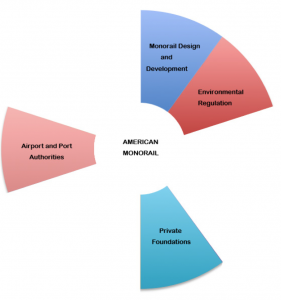 New Performance Goals and Standards
New Performance Goals and Standards
Environmental regulatory agencies’ primary role and jurisdiction with regard to transportation planning and operations has been historically confined to regulation and enforcing of limitations on transportation systems, vehicles, manufacturing, maintenance and operation. Focused on reduction or elimination of pollution and other forms of environmental damage caused by the full spectrum of transportation components, from manufacturing and energy consumption to daily operations and eventual scrapping of transportation equipment, environmental regulations and enforcement agencies have historically concentrated on the impacts of automobiles, while considering all other forms of transportation to be less damaging, and therefore preferable to autos in most every respect. This has tended to set performance standards for mass transportation systems well below optimal.
Environmental regulatory agencies can initiate proactive, rather than restrictive or punitive measures and performance standards that could solve or eliminate protracted regulatory efforts to clean up existing transportation equipment and practices. In light of the California Attorney General’s virtual suspension of Los Angeles County’s Santa Clarita Valley Area Plan, for its failure to address and adequately reduce the production of greenhouse gasses, the relationship between transportation and urban growth will have to be fundamentally reconsidered. By encouraging or mandating a reshaping of transportation industry and practices, environmental regulatory agencies and authorities can accelerate the evolution of transportation systems and vehicle performance to the benefit of all interests and constituencies, as well as, the environment. And, coordination of these efforts with monorail industry and planners can focus their modernization initiatives on the most productive and practical solutions to environmental issues confronting environmental regulators, as well as, the monorail service industry.
Active support and participation in the transformation of Long Beach Harbor cargo distribution networks from the inefficient, excessively polluting diesel truck and train cargo distribution systems that clog streets and freeways for miles around the port, and are a major source of air pollution in the Los Angeles basin, to a completely separate and independent, electrically powered monorail cargo-transport system could achieve a range of environmental objectives while expediting development of a state of the art cargo distribution system enhancing every aspect of port, shipping and railroad operations. Bringing the private business interests that conduct the vast majority of shipping and cargo distribution through the Long Beach Port together in a structured forum with the public and government regulatory agencies charged with balancing the economic and environmental concerns of the whole system, would promote the success of all interests involved in the port’s operation.
By setting modern performance standards for transportation systems and equipment, environmental authorities can guide, as well as, support the development of environmentally and economically effective transportation solutions to long-standing environmental problems, while promoting the modernization of transportation industry and practices.




